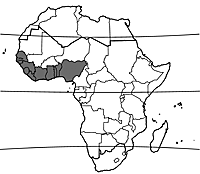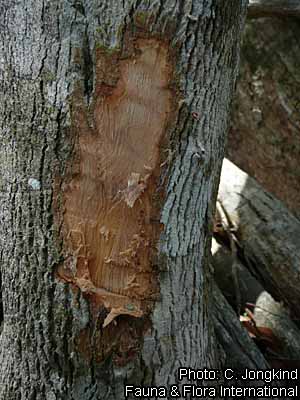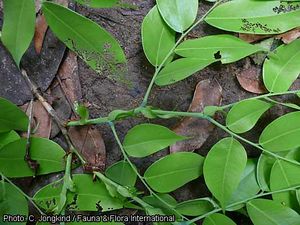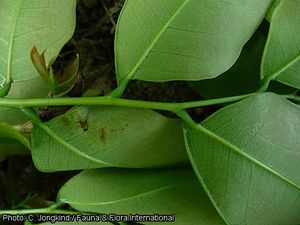Crudia senegalensis (PROTA)
Introduction |
Crudia senegalensis Planch. ex Benth.
- Protologue: Trans. Linn. Soc. 25: 314 (1865).
- Family: Caesalpiniaceae (Leguminosae - Caesalpinioideae)
Origin and geographic distribution
Crudia senegalensis is widespread in West Africa, from Guinea-Bissau east to south-western Nigeria.
Uses
The very heavy and hard wood is rarely used, but it has been used for boards in Sierra Leone. The tree is valued as an ornamental shade tree.
Properties
The wood is greyish brown, often dark brown in the centre of the log. It has a moderately fine texture and it is very hard, making it very difficult to saw and work.
Description
- Small to medium-sized tree up to 30 m tall; bole often low-branching and crooked, up to 90(–100) cm in diameter, with narrow buttresses; bark surface irregularly scaly, greyish brown, inner bark fibrous, reddish brown; crown spreading; twigs glabrous.
- Leaves alternate, imparipinnately compound with 6–12 leaflets; stipules narrowly ovate, united at base, 1–3(–4) cm long, persistent; petiole 1–2(–2.5) cm long, rachis up to 15(–19) cm long; petiolules 1–3 mm long, twisted; leaflets alternate, ovate-elliptical to obovate, (1.5–)5–10(–15) cm × (1–)2–5(–7) cm, slightly asymmetrical, glabrous.
- Inflorescence an axillary or terminal raceme up to 21 cm long, glabrous, loosely flowered.
- Flowers bisexual, regular, greenish; pedicel 1.5–2.5 cm long; sepals usually 4, elliptical, 5–7 mm long, glabrous outside, short-hairy inside; petals absent; stamens 10, free, 1–1.5 cm long; ovary superior, c. 0.5 cm long, hairy, style c. 1 cm long.
- Fruit an elliptical to nearly round, flattened pod 5–12 cm × 4–7 cm, hairy, dehiscing by 2 woody valves, 1–2-seeded.
- Seeds elliptical to nearly round, flattened, 4–6 cm long, glabrous, brown.
- Seedling with epigeal germination, but seemingly hypogeal; hypocotyl c. 0.5 cm long, epicotyl 14–20 cm long; cotyledons remaining within the seed coat; first leaves alternate, with 3(–4) pairs of opposite leaflets.
Other botanical information
There is no information on growth rates of Crudia senegalensis, but probably trees grow slowly. In Gabon young trees of Crudia gabonensis Pierre ex De Wild. reached a mean annual bole diameter growth of 8 mm, older trees 1–3 mm. In Côte d’Ivoire trees of Crudia senegalensis flower in October to February and fruits mature in January to March(–May).
Crudia comprises about 55 species, of which about 30 in tropical Asia, 10 in tropical America and 10 in West and Central Africa. Its affinity is still uncertain. Several other Crudia spp. become medium-sized and sometimes even large trees, and their wood may be used occasionally, although it is extremely hard and difficult to cut.
Crudia gabonensis
One of these is Crudia gabonensis, which may become 50 m tall with a bole up to 125 cm in diameter; it is found from Côte d’Ivoire to Gabon and Congo.
Ecology
Crudia senegalensis occurs in lowland rainforest, often in swamp forest and along rivers and lagoons, up to 50 m altitude.
Management
There are about 100 seeds per kg. Germination starts 2–3 months after sowing and the germination rate is low. Pre-treatment of the seeds is needed to obtain fair germination results.
Genetic resources
Although Crudia senegalensis is widespread in West Africa, it occurs usually scattered, most commonly in riverine and swamp forest. Therefore, it may be liable to genetic erosion when these forest types decline.
Prospects
The timber of Crudia senegalensis and other Crudia spp. will not become commercially interesting because of scattered occurrence and low growth rates of the trees, and the difficulties in sawing and working the wood.
Major references
- Berhaut, J., 1975. Flore illustrée du Sénégal. Dicotylédones. Volume 4. Ficoidées à Légumineuses. Gouvernement du Sénégal, Ministère du Développement Rural et de l’Hydraulique, Direction des Eaux et Forêts, Dakar, Senegal. 625 pp.
- Breteler, F.J. & Nguema Miyono, N.S., 2008. Revision of the African species of Crudia (Leguminosae, Caesalpinioideae). Systematics and Geography of Plants 78: 81–110.
- Burkill, H.M., 1995. The useful plants of West Tropical Africa. 2nd Edition. Volume 3, Families J–L. Royal Botanic Gardens, Kew, Richmond, United Kingdom. 857 pp.
- de Koning, J., 1983. La forêt de Banco. Part 2: La Flore. Mededelingen Landbouwhogeschool Wageningen 83–1. Wageningen, Netherlands. 921 pp.
- Savill, P.S. & Fox, J.E.D., 1967. Trees of Sierra Leone. Forest Department, Freetown, Sierra Leone. 316 pp.
Other references
- Aubréville, A., 1959. La flore forestière de la Côte d’Ivoire. Deuxième édition révisée. Tome premier. Publication No 15. Centre Technique Forestier Tropical, Nogent-sur-Marne, France. 369 pp.
- de la Mensbruge, G., 1966. La germination et les plantules des essences arborées de la forêt dense humide de la Côte d’Ivoire. Centre Technique Forestier Tropical, Nogent-sur-Marne, France. 389 pp.
- Hawthorne, W. & Jongkind, C., 2006. Woody plants of western African forests: a guide to the forest trees, shrubs and lianes from Senegal to Ghana. Kew Publishing, Royal Botanic Gardens, Kew, United Kingdom. 1023 pp.
- Keay, R.W.J., 1989. Trees of Nigeria. A revised version of Nigerian trees (1960, 1964) by Keay, R.W.J., Onochie, C.F.A. & Stanfield, D.P. Clarendon Press, Oxford, United Kingdom. 476 pp.
- Lewis, G., Schrire, B., MacKinder, B. & Lock, M., 2005. Legumes of the world. Royal Botanic Gardens, Kew, Richmond, United Kingdom. 577 pp.
- Normand, D., 1950. Atlas des bois de la Côte d’Ivoire. Tome 1. Centre Technique Forestier Tropical, Nogent-sur-Marne, France. 148 pp.
- Normand, D. & Paquis, J., 1976. Manuel d’identification des bois commerciaux. Tome 2. Afrique guinéo-congolaise. Centre Technique Forestier Tropical, Nogent-sur-Marne, France. 335 pp.
- Vivien, J. & Faure, J.J., 1985. Arbres des forêts denses d’Afrique Centrale. Agence de Coopération Culturelle et Technique, Paris, France. 565 pp.
Author(s)
- R.H.M.J. Lemmens, PROTA Network Office Europe, Wageningen University, P.O. Box 341, 6700 AH Wageningen, Netherlands
Correct citation of this article
Lemmens, R.H.M.J., 2010. Crudia senegalensis Planch. ex Benth. [Internet] Record from PROTA4U. Lemmens, R.H.M.J., Louppe, D. & Oteng-Amoako, A.A. (Editors). PROTA (Plant Resources of Tropical Africa / Ressources végétales de l’Afrique tropicale), Wageningen, Netherlands.
Accessed 17 December 2024.
- See the Prota4U database.




